Entomology Exam 2
1/68
There's no tags or description
Looks like no tags are added yet.
Name | Mastery | Learn | Test | Matching | Spaced |
|---|
No study sessions yet.
69 Terms
What are the three tagmata
Head, thorax, abdomen
Important constituents of head tagmata
sclerotized capsule used for sensation, eating, and information processing
Important constituents of thorax tagmata
3 ancestral segments each bearing 1 pair of legs, segments 2+3 with wings, used for locomotion
Important constituents of abdomen tagmata
multiple segment, contains digestive tracts, genitalia (reproduction), and air sacs for respiration; some larvae / nymphs also use it for locomotion; digestion, reproduction, respiration
What are the layers of integument
cuticle, epidermis, and basement membrane
Cuticle purpose & components
non-cellular layer “exoskeleton” provides most of the structural main functions of integument
Epidermis purpose & components
one-cell-thick layer of living cells, secretes cuticle and performs glandular and sensory functions of integument
Basement membrane purpose & componentss
non-cellular layer (like chicken egg membrane), provides scaffolding for epidermis
tagmosis
the fusion of segments into functional units
tagma (pl. tagmata)
the distinct functional body regions formed by the fusion and differentiation of segments
Cephalization
creating the head from a fusion of 6 ancestral segments into a single, highly sclerotized capsule
Sclerotization (tanning)
the process by which an insect's or arachnid's exoskeleton hardens and darken (crosslinking various proteins called sclerotins)
Sclerite
a component section of an exoskeleton
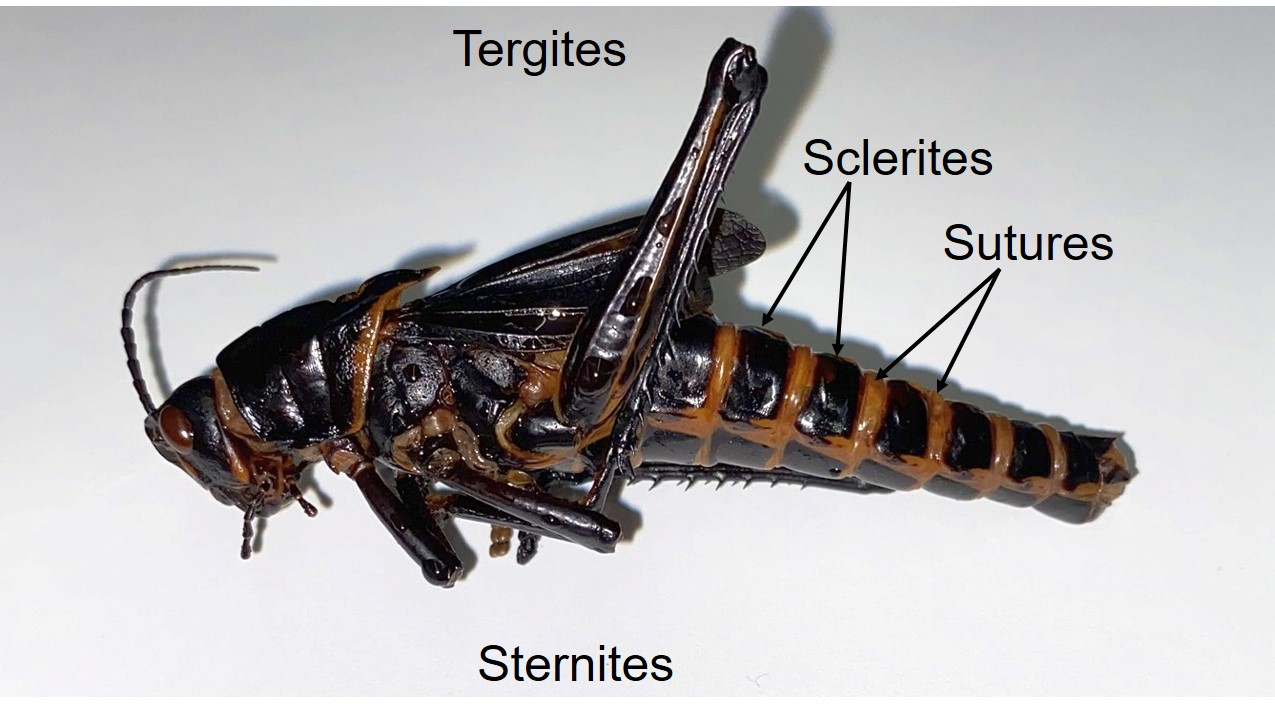
Sclerotins
the proteins reinforcing exoskeletons through crosslinkage (stiffens chitin)
Cerci
a pair of appendages found at the end of an insect's abdomen that primarily function as sensory organs (helping the insect detect air currents, vibrations, and potential predators)
Tergite (tergum, pl. = terga) vs. sternite (sternum, pl. = sterna)
sclerites on the dorsal vs. ventral abdomen
Pleural membrane
soft part of the cuticle that joins tergites and sternites laterally (enables abdomen expansion)
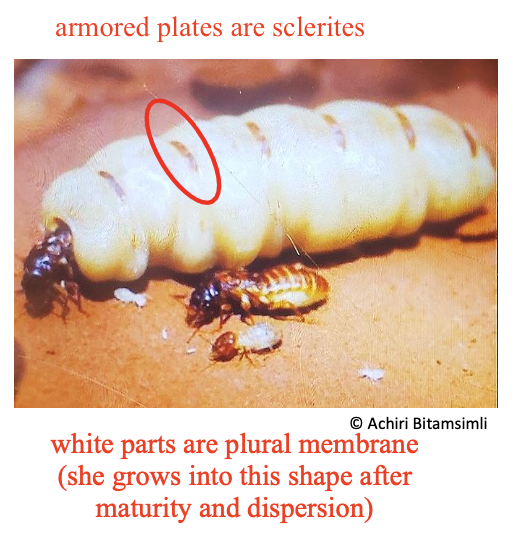
Integument meaning
outer covering of the body
Main sections of insect integument
cuticle (exoskeleton), epidermis, basement membrane
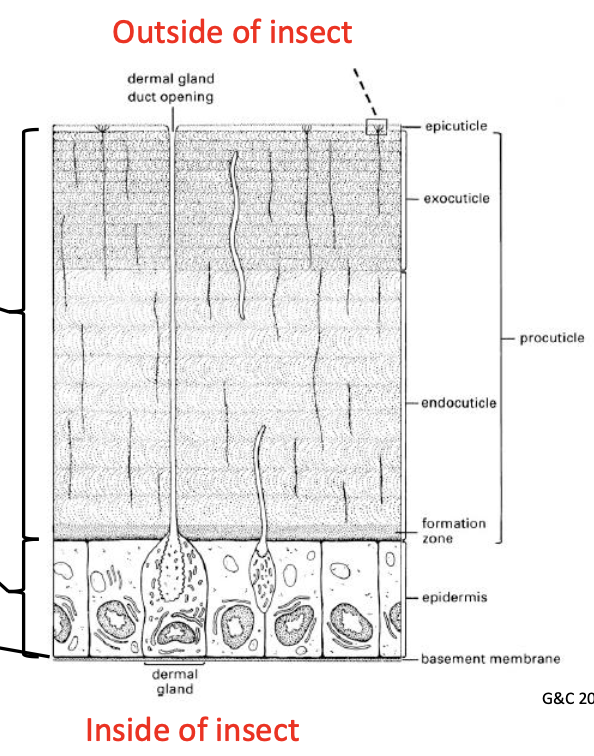
Functions performed by the insect integument
Skeletal support, Locomotion, Water conservation, Sensory capabilities, Defense and offense,Exocrine glands, Respiration, Digestion
Layers of the cuticle
Epicuticle (outermost), exocuticle, endocuticle
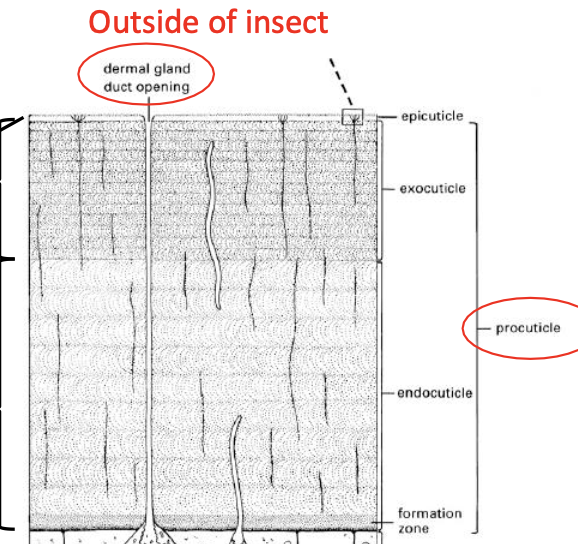
What is Epicuticle made out of and what does it do
lipoproteins, waxes, oils; like “paint job” of cars and does not provide structural support but rather chemical interfacing with outside world (including water retention)
What is Exocuticle made out of and what does it do
cross-linked (sclerotized) chitin and proteins, is rigid and hard to provide structural support, also most responsible for color
What is Endocuticle made out of and what does it do
non-cross-linked chitin and proteins, is strong and flexible but not rigid or hard
How does color work in insects
mostly structural (light reflected/refracted) based on structure of chitin matrix (NOT chemicals like dyes)
How is chitin used in insect integument
forms the structural foundation, providing rigid exoskeleton that offers protection, support, and acts as a barrier against water loss
steps of ecdysis
Proliferation of epidermal cells
Apolysis: separation of old cuticle from epidermis
Secretion of inactive molting gel by epidermis
Production of epicuticle layer for new cuticle
Activation of molting fluid
Digestion and absorption of old endocuticle; epidermis
secretes new procuticle
Ecdysis: shedding the old exocuticle and epicuticle
Expansion of new integument
Sclerotization of new exocuticle
what is chitin
amino polysacchiride similar to cellulose arranged in microfibrils sheets (lamellae) layered out of alignment for more tensile strength; made rigid and hard (also brittle and unrecoverable chemically) by sclerotization (also usually darkens cuticle)
Limitations of a chitinous cuticle
size constraints (tubular structures aka insect limbs/body cavities are strongest at small diameter), cannot grow continuously (must molt)
chitin lamellae
sheets of microfibrils
chitin microfibril
bundles of H-bonded chitin embedded in a protein matrix
scaling laws (of physics)
Commonly encountered forces (such as adhesion, air resistance, kinetic energy) acts on insects differently from how we experience the forces because some forces scale linearly, others with the square, and others with the cube of one’s body length
how are physics “different” for insects
adhesion is strong for insects, kinetic energy is weak for insects, air is “gooey”
synchronous muscles
1 neural signal = 1 contraction, in all animals
asynchronous muscles
1 neural signal = many contractions, generates extremely fast wingbeats, only in insects
why can insect legs move faster than human legs in terms of number of steps per unit time
forces scale differently with muscle strength and cross sectional area relative to mass/inertia of each leg
myosin and actin
cause contraction of muscle fibers
apodemes
internal ridges/ingrowths of the integument that serve as attachment points for muscles
prolegs
non-jointed appendages on the abdomen of some insect larvae used for gripping and locomotion

Resilin
a rubber-like protein in insects that acts as a molecular spring
Metafemoral spring
triangular plate
elastic plate
direct vs. indirect flight
muscles attached to wings vs. muscles distorting thorax to move wings
pros and cons for direct flight
pros and cons for indirect flight
the only orders who use direct flight (hint: Paleoptera orders)
Odonata, Ephemeroptera (mayflies)
evidence for flight being a costly investment
secondarily wingless insects; alates in insects that have both winged and wingless forms
examples of how wings are used for purposes other than flight
Ruan et al. 2020: what question did they set out to solve?
How do flea beetles achieve impressive jumps? (previous research disagrees)
Ruan et al. 2020: What was their experimental approach?
Micro-CT scanning analysis of 7 species to build 3D models of internal structure, 13 genera dissected, high speed filming of 4 species
Ruan et al. 2020: What did they find out about how flea beetles jump (what body parts are involved to generate and release the necessary forces)?
Tibial extensors stretch metafemoral spring to store elastic force, tibial flexor keeps tibia folded with help of triangular and elastic plate acting as latch/protection mechanism
Ruan et al. 2020: What were the implications of their study?
information can be compared with other groups that store kinetic energy for rapid movement OR can be used to design robot based on beetle’s hind legs
How does the jumping mechanism studied in Ruan et al. 2020 work in principle? What parts are involved?
parts involved: the tibial flexor and tensor muscles, metafemoral spring, Lever’s triangular plate, elastic plate
Arolia
a pad-like organ on the underside of the insect "foot", formed by an extension of the last tarsal segment
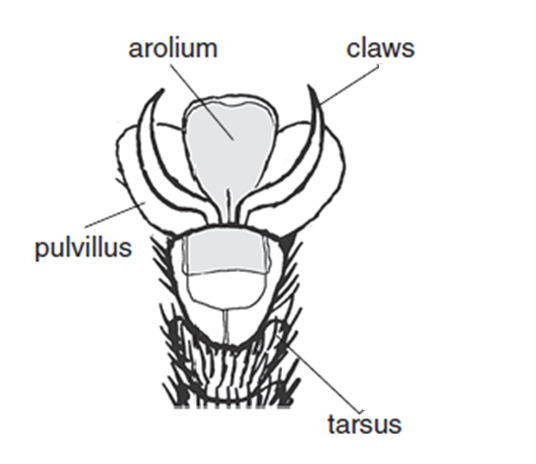
pulvilli
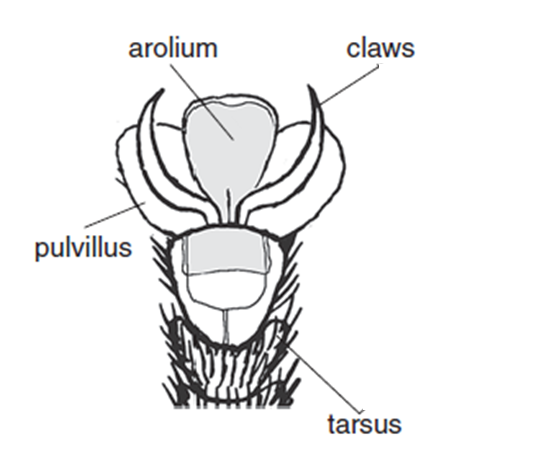
how are insect legs used to stick to surfaces
arolia/pulvilli secrete fluids and/or bear tiny hairs to adhere to smooth surfaces, surface tension and adhesion forces hold on water, Van der Waals forces on walls